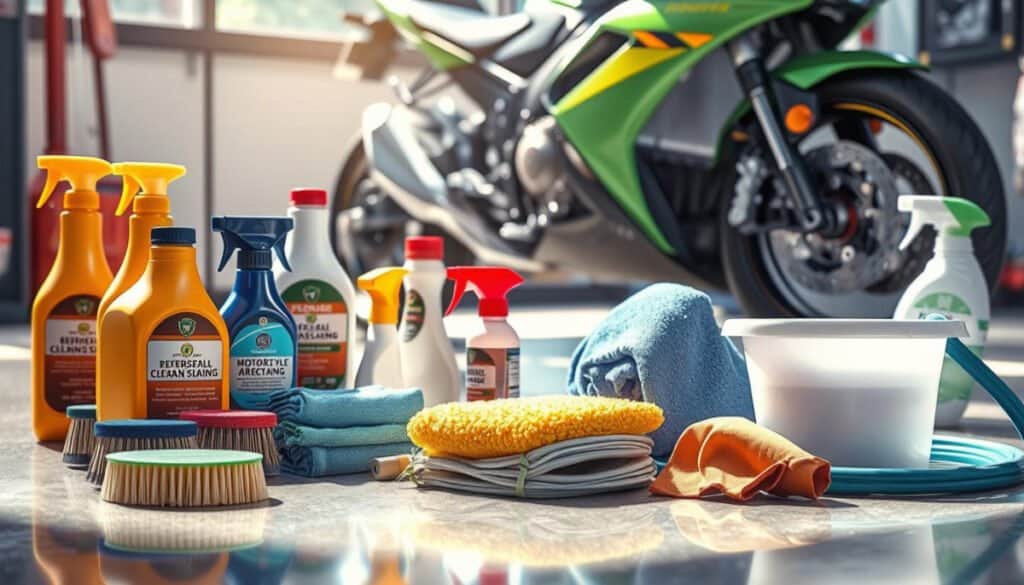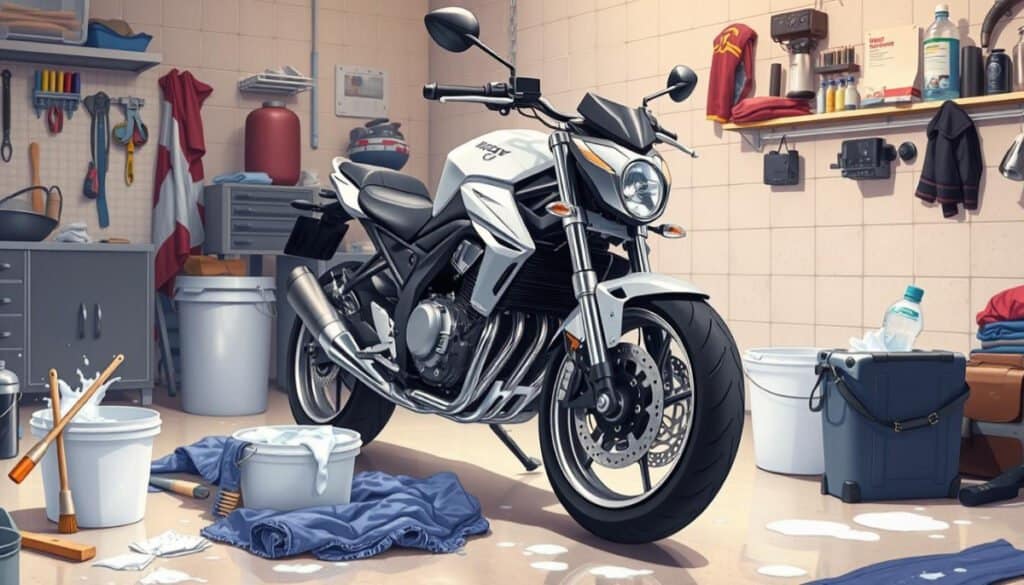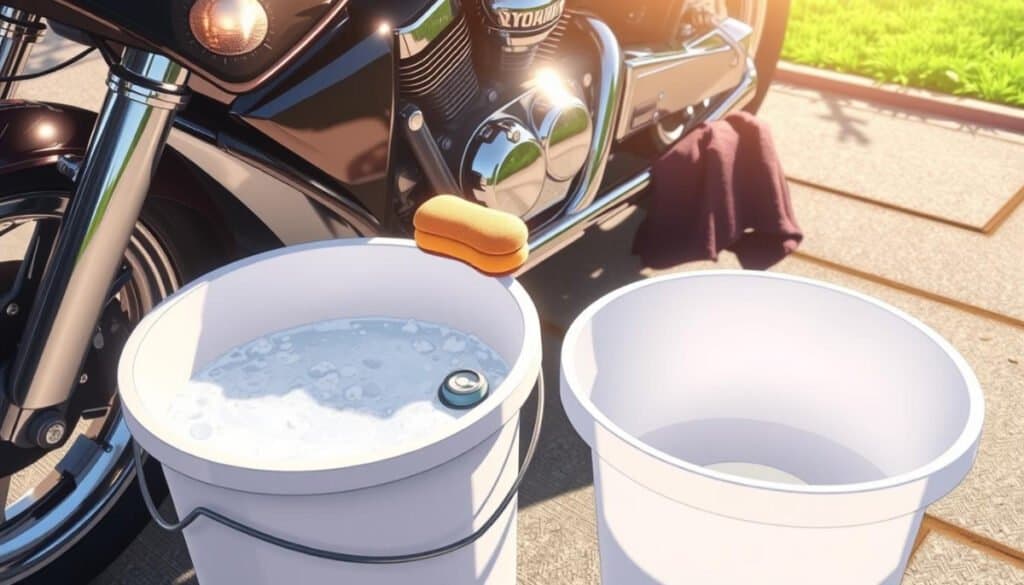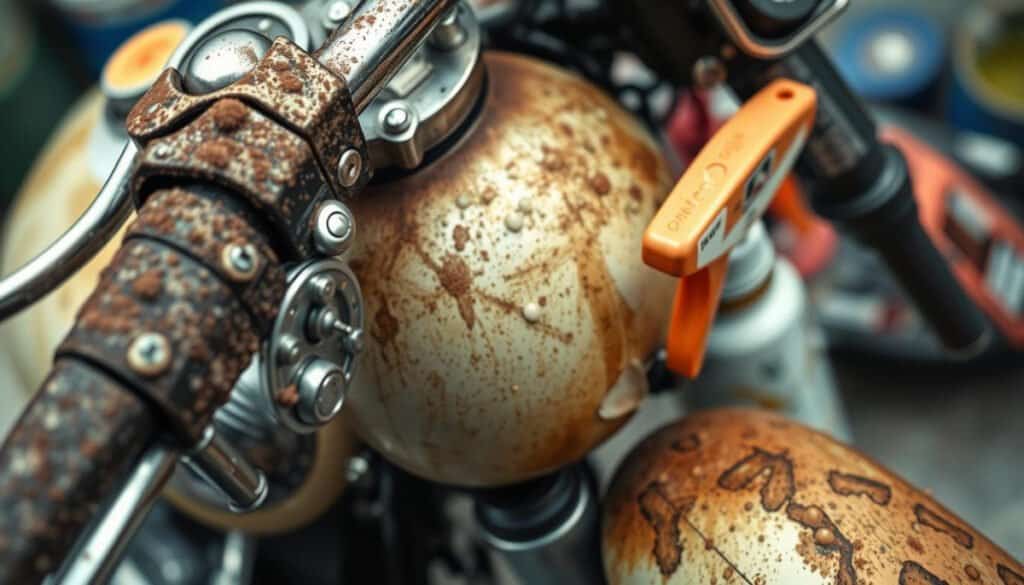Ever wondered why your motorcycle’s shine fades faster than you’d like? The secret lies in proper cleaning techniques. Regular motorcycle maintenance isn’t just about keeping your bike looking pristine; it’s a crucial step in preserving its performance and longevity.
Cleaning your motorcycle is more than just a quick rinse and wipe. It’s an art that requires the right tools, techniques, and patience. With 60% of motorcycle cleaning focussing on the ‘dos’ and 40% on the ‘don’ts’, it’s clear that knowing both is equally important for effective motorbike detailing.
Did you know that 75% of motorcycle owner’s manuals provide specific cleaning product recommendations? Or that 90% of motorcycle owners use microfibre cloths to prevent scratches? These bike cleaning tips are just the tip of the iceberg regarding proper motorcycle care.
Let’s discuss the essential steps of motorcycle cleaning, from using the right shampoo to avoiding common pitfalls. We’ll cover everything from pre-cleaning checks to post-cleaning care, ensuring your bike stays in top condition ride after ride.
Essential Supplies and Equipment for Motorcycle Cleaning
To wash your motorcycle, you need the right cleaning products. A good detailing kit has pH-balanced shampoos, microfiber mitts, terry towels, quality wax, metal polish, and foam applicators.

Motorcycle-Specific Cleaning Products
Specialised cleaners are key for effective cleaning without harm. Chemical Guys Mr. Pink car wash soap is a favourite for gentle yet deep cleaning. Motul MC Care C2 Chain Lube Road is a good pick for chain care. Feel free to recommend your cleaning products in the comments below.
Tools and Accessories
For a good motorcycle wash, you’ll need:
- Two buckets with dirt traps
- Microfiber cloths for drying and polishing
- Soft brushes for hard-to-reach spots
- Orbital polishers for a pro finish
For polishing, use orbital tools with the right polish and pads. Apply wax in circles with a buffing pad until it’s even and shiny.
Safety Equipment
Wear gloves and safety glasses to protect yourself. Avoid high-pressure washers to avoid damaging the bike and its components. Clean in the shade on a cool surface to avoid soap spots and streaks.
These products and tools will give your bike a deep clean while keeping its finish in top shape. Remember, cleaning right aids in keeping your motorcycle running well and looking great.
Pre-Cleaning Preparation and Safety Checks
Before you start cleaning your motorcycle, make sure you’re ready and safe. The right way to clean your motorcycle begins with good preparation.
Find a shaded spot to park your motorcycle and let it cool down fully. This will prevent streaks and keep everything cool during cleaning. A cool engine is safer and less likely to be damaged by sudden temperature changes.

Consider checking your local laws about cleaning in open spaces. Some places have rules to protect groundwater from oil and chemicals. Following these laws is part of being a responsible motorcycle owner.
Get your cleaning tools ready:
- Two buckets for the two-bucket washing method
- Microfibre cloths to avoid scratches
- Specialised brushes for hard spots
- High-quality motorcycle cleaner for tough dirt
Shield your motorcycle’s sensitive parts. Cover electrical bits and muffler outlets to prevent water damage. Block the exhaust pipe for petrol bikes. Electric bikes are more water-resistant but still need care.
Regular cleaning keeps your bike looking good and helps spot problems early. This prevents accidents and keeps your engine running smoothly. With these steps, you’re set to clean your motorcycle safely and effectively.
How-to Properly Clean Your Motorcycle
Washing motorcycles requires care and attention to detail. Let’s look at the best ways to clean your bike.
Two-Bucket Washing Method
The two-bucket method is a big help for cleaning bikes. Use one bucket for motorcycle shampoo and water, and the other for clean water. This stops dirt from getting back on your bike’s surfaces.

Proper Cleaning Sequence
Begin at the top and move down when cleaning. Use cool water to loosen dirt before wiping with a sponge or cloth. Clean plastic parts with a bit of soapy water.
For non-chrome engine parts, use water and solvent carefully. Avoid brake lines and bearings.
- Rinse thoroughly with cool water
- Use motorcycle-specific products
- Dry with a chamois or microfiber cloth
Hard-to-Reach Areas
An old toothbrush is great for hard spots. Use a chain degreaser to clean the motorcycle chain. Protect important bearings with a special spray.
After cleaning, apply protective wax to keep the finish and repel dirt. Don’t forget to test your brakes and lubricate the drive chain before riding.
Dealing with Stubborn Dirt and Stains
Keeping your motorcycle clean can be challenging, especially with stubborn dirt and stains. To handle these issues well, you need special techniques for motorbike detailing. For tough bugs, use hot water or a bug remover to loosen them first. Then, clean the area gently.
When dealing with road salt, use cool water. Warm water can make it worse. For heat stains on exhaust pipes, a liquid abrasive works best. Soak dirty parts and dead insects in soap solution before rinsing with water.

Using a microfiber cloth is key for cleaning your motorcycle. It prevents scratches and ensures a deep clean. The two-bucket method is excellent for regular washing. It prevents dirt from spreading and cleans better.
A degreaser removes oil and dirt stains on painted metal, plastics, or engine parts. WD-40 removes stubborn dirt and asphalt or tar from your bike.
Different surfaces need different cleaning methods. For matte plastics, mix baking soda, white vinegar, and water for good results. When waxing, consider the protection time and ease of application of traditional and spray wax.
Cleaning Different Motorcycle Surfaces
Keeping your motorcycle in top shape means cleaning each part right. Every bit of your bike needs special care to last long and run well.
Paint and Chrome Care
To keep the finish safe, use a pH-balanced soap for painted surfaces. Chemical Guys Mr. Pink is great for its foamy action. Chrome parts need special polish to shine and remove tarnish. It’s good to remember that a clean and shiny bike can sell for more!
Wheel and Tyre Maintenance
Wheels get dirty from brake dust and road dirt. A rim cleaner can make them shine again. For tyres, a stiff brush is best for dirt stuck in the grooves. Clean wheels well to catch problems early (as World SuperBike teams do before races).
Plastic and Rubber Components
Wash plastic parts with a neutral soap. For tough stains, consider trying Chemical Guys Orange Degreaser. Rubber parts need gentle cleaning to avoid harm. Apply a protective layer after washing to stop cracking and fading.
Don’t forget underneath
Remember to clean the underside of your bike, as it’s often overlooked. Plus, if you do happen to come off the bike, it will at least look nice and shiny as it slides down the road!
Common Mistakes to Avoid During Cleaning
When washing your motorcycle, pay close attention to every detail. Many riders make mistakes that can damage their bikes. Let’s look at some common errors to avoid when cleaning your motorcycle.
Using car wash facilities or pressure washers is a big no-no. These can harm your bike’s sensitive parts. Always wait for your bike to cool down before washing. Cleaning a hot engine can cause it to warp and other problems.
Don’t scrub too hard to remove bugs, as it can damage your paint. Use a soft cloth and special cleaners instead. Avoid using car shampoos or household detergents. They often have harsh chemicals that can harm your bike’s surfaces.
- Don’t neglect hard-to-reach areas
- Avoid using abrasive materials on chrome or aluminium parts
- Never use products not designed for motorcycles
Some riders use Armorall on seats, making them slippery and unsafe. Stick to proper motorcycle cleaning techniques and products made for bikes.
Regular cleaning stops oxidation and corrosion, especially on spokes and metal parts. It’s not just about looks; it keeps your bike in good shape, improves ride quality, and helps it hold its value.
Remember, a clean motorcycle is easier to check for problems. Use cleaning time to spot any issues or repairs needed.
Post-Cleaning Care and Protection
After washing your motorcycle, it’s important to take care of it. This final step helps keep your bike looking good and running well. It involves a few things you can do to keep your motorcycle in top shape.
Drying Techniques
Drying your motorcycle well will help to avoid water spots and corrosion. Use a high-quality microfiber cloth for drying. These cloths are soft on the paint and chrome, so your bike won’t get scratched.
Waxing and Polishing
Waxing and polishing shield your motorcycle’s paint from sun and heat. For the best results, choose pure carnauba wax or something similar. If you see swirl marks or ‘spider webs’, use an orbital polisher if you have one or quality foam pads to fix them.

Chain Lubrication
Don’t forget to oil your motorcycle chain after cleaning. Not doing this can harm your bike’s performance and cause damage. Keeping the chain well-lubricated is essential for your bike’s smooth running and longevity.
Remember, keeping your motorcycle clean is more than just washing it. By following these tips, your bike will look in excellent condition for many years.
Special Considerations for Different Weather Conditions
The weather is key in keeping your motorcycle in good shape. Your cleaning routine must change with the seasons. In winter, road salt can damage your bike’s surfaces.
In summer, bugs stick to your bike’s lights and mirrors, which require extra care in your cleaning routine.
Although it is not recommended, use a medium setting on pressure washers when washing your bike if you find yourself using them. Keep a 15-centimetre distance to avoid damage. Regular chain lubrication every 300 to 500 kilometres is a crucial maintenance step to not overlook after washing your bike.
Key Takeaways
- Regular cleaning is suitable for motorcycle longevity and performance
- Use motorcycle-specific cleaning products to avoid damage
- The two-bucket washing method prevents recontamination
- Pay attention to hard-to-reach areas during cleaning
- Post-cleaning care, including lubrication, is a must
- Adapt cleaning techniques for different weather conditions
Conclusion
Learning to clean your motorcycle right is key to keeping it in top shape. Regular cleaning makes your bike look great and stops damage from dirt and grime.
Good motorcycle cleaning is all about a detailed approach. About 75% of the work is cleaning the body and parts well. The rest involves washing, degreasing, drying, and polishing for that showroom look. Always clean from top to bottom to avoid dirty water on clean spots.
Using the right tools and products is crucial, and 80% of the results depend on them. You’ll need cleaning foams, brushes, microfiber cloths, and protective gear. When rinsing, be careful not to spray high-pressure water on sensitive parts. Lastly, consider having a regular cleaning schedule to keep your motorcycle looking new.
FAQ
How often should I clean my motorcycle?
Your cleaning schedule depends on your riding habits and the environment. A good rule of thumb is to wash your bike every two weeks or after a dirty ride. Clean more often in winter or when riding on salted roads.
Can I use car shampoo or household detergents to clean my motorcycle?
No, don’t use car shampoos or household cleaners on your bike. They can harm the paint and parts. Always choose motorcycle-specific cleaners for each surface of your bike.
Is it safe to use a pressure washer on my motorcycle?
Using a pressure washer on your motorcycle is not advised. The high-pressure water can damage parts and get into sensitive areas. Instead, use a gentle hose with a spray nozzle for rinsing.
What’s the best way to clean stubborn bugs off my motorcycle?
Start with hot water or a bug remover for tricky, sticky bugs. Then, gently clean without scrubbing hard. Soaking the area in soap before rinsing can also help.
How should I clean my motorcycle’s chain?
Use a chain cleaner and brush to clean your bike’s chain. Dry it well and then apply lubricant. This keeps the chain from rusting and working well.
Can I clean my motorcycle immediately after riding?
For gas bikes, wait for the engine and exhaust to cool before cleaning. This avoids damage from sudden temperature changes. On the other hand, electric motorcycles can sometimes be cleaned right away because of their sealed systems. If you are unsure, always check your manufacturer’s recommendations.
How do I clean my motorcycle’s wheels without damaging them?
For painted aluminium wheels, use a wet sponge and mild detergent. Avoid stiff brushes or harsh cleaners. Chrome wheels need a specific polish. Always check your owner’s manual for the best cleaning method.
What should I do after cleaning my motorcycle?
After cleaning, dry your bike with a soft cloth or chamois to avoid water spots. Apply wax or polish to protect the paint. Lubricate the chain, cables, and levers. Start the engine, let it run for a few minutes, and test the brakes before riding.
How can I protect my motorcycle during winter?
In winter, clean your bike more often to remove salt. Use cool water and dry it well. Apply protective sprays or wax to metal. Use winter protection products recommended by your dealer.
Are there any special considerations for cleaning electric motorcycles?
Electric bikes, like Damon models, have sealed systems and are water-resistant. However, they should always be cleaned according to the manufacturer’s guidelines.
Closing thoughts
It can be satisfying to have a nice, clean motorcycle, yet it’s frustrating to keep getting it dirty, depending on the seasons, weather, and roads you ride. If nothing else, just wiping surfaces gently can make a quick difference in the bike’s appearance. I can’t resist using WD-40 for those quick clean-ups on metal parts and to remove stubborn or oily marks.
Which motorcycle cleaning products do you use and recommend?
